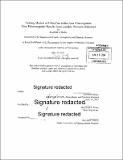Testing models of ultra-fast India-Asia convergence : new paleomagnetic results from Ladakh, Western Himalaya
Author(s)
Bailey, Elizabeth A
DownloadFull printable version (3.869Mb)
Other Contributors
Massachusetts Institute of Technology. Department of Earth, Atmospheric, and Planetary Sciences.
Advisor
Benjamin P. Weiss.
Terms of use
Metadata
Show full item recordAbstract
Rapid India-Asia convergence has led to a major continental collision and formation of the Himalayas, the highest mountain range on Earth. Knowledge of the paleolatitude of the Kohistan-Ladakh Arc (KLA), an intermediate tectonic unit currently situated between the converging Indian and Eurasian continents in Western Himalaya, would constrain the tectonic history and dynamics of Himalayan orogenesis. We present new paleomagnetic data from the Khardung volcanic rocks of the Shyok-Nubra valley region of Ladakh, western Himalaya. Samples from all four sites (KP1-KP4) display high-temperature components indicating a roughly equatorial paleolatitude, with the average of site mean directions implying a paleolatitude of 5'N. We interpret results of a positive baked contact test at one site (KP3) to imply that the high-temperature components in the distal volcanic bedrock predate bedding tilt and dike formation. Previous studies of the Khardung unit (Bhutani 2009, Dunlap 2002) have measured 40Ar-39Ar and U-Pb dates of -52-67 Ma. Assuming these ages apply to our samples, our results support the two-stage collision model of Jagoutz and Royden (in prep), which indicates an approximately equatorial India-KLA collision at 50 Ma.
Description
Thesis: S.B., Massachusetts Institute of Technology, Department of Mathematics, 2014. Author received an S.B. from the Department of Mathematics, but her thesis was submitted to the Department of Earth, Atmospheric and Planetary Sciences for the degree of S.B. Cataloged from PDF version of thesis. Includes bibliographical references (pages 29-32).
Date issued
2014Department
Massachusetts Institute of Technology. Department of MathematicsPublisher
Massachusetts Institute of Technology
Keywords
Mathematics., Earth, Atmospheric, and Planetary Sciences.